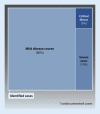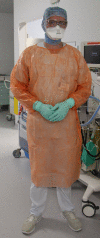Coronavirus disease 2019 (COVID-19): update for anesthesiologists and intensivists March 2020
- PMID: 32211920
- PMCID: PMC7095212
- DOI: 10.1007/s00101-020-00760-3
Coronavirus disease 2019 (COVID-19): update for anesthesiologists and intensivists March 2020
Abstract
The current outbreak of coronavirus disease (COVID-19) has reached Germany. The majority of people infected present with mild disease, but there are severe cases that need intensive care. Unlike other acute infectious diseases progressing to sepsis, the severe courses of COVID19 seemingly show prolonged progression from onset of first symptoms to life-threatening deterioration of (primarily) lung function. Diagnosis relies on PCR using specimens from the respiratory tract. Severe ARDS reflects the hallmark of a critical course of the disease. Preventing nosocomial infections (primarily by correct use of personal protective equipment) and maintenance of hospitals' operational capability are of utmost importance. Departments of Anaesthesia, Intensive Care and emergency medicine will envisage major challenges.
Die neu aufgetretene Atemwegserkrankung „coronavirus disease 2019“ (COVID-19) hat Deutschland erreicht. Die Erkrankung verläuft in den meisten Fällen leicht, aber der kleinere Anteil an schwer Erkrankten wird stationär und auch intensivmedizinisch behandelt werden. Im Gegensatz zu anderen akuten Infektionskrankheiten zeigen die schweren Verläufe eine langsame Progredienz von den ersten Symptomen bis zur lebensbedrohlichen Verschlechterung. Die Diagnosestellung erfolgt mithilfe der Polymerase-Kettenreaktion (PCR) aus Proben des Respirationstrakts. Ein schweres „acute respiratory distress syndrome“ (ARDS) ist charakteristisch für die kritischen Verläufe. Der Vermeidung nosokomialer Infektionen, insbesondere durch korrekte Anwendung der Schutzausrüstung, und der Aufrechterhaltung des Krankenhausbetriebs kommen zentrale Bedeutung zu. Auch in der Anästhesie und Notfallmedizin ist mit erheblichen Herausforderungen zu rechnen.
Keywords: Anesthesiology; Emergency medicine; Infection control; Infectious disease outbreaks; Intensive care.
© 2020. Springer Medizin Verlag GmbH, ein Teil von Springer Nature.
Conflict of interest statement
D. Thomas-Rüddel, J. Winning, P. Dickmann, D. Ouart, A. Kortgen, U. Janssens and M. Bauer declare that they have no competing interests.
Figures







References
-
- Gardner L. Johns Hopkins Center for Systems Science and Engineering. 2020. Update January 31: Modeling the Spreading Risk of 2019-nCoV.
-
- Imai N, Cori A, Dorigatti I, Baguelin M, Donnelly CA, Riley S, Ferguson N. Imperial College London. 2020. Report 3: Transmissibility of 2019-nCoV.
-
- McCandless D, Kashan O, Quick M, Webster K, Starling S. Information is beatiful. 2020. The microbe scope—infectious diseases in context.
-
- Chen N, Zhou M, Dong X, Qu J, Gong F, Han Y, Qiu Y, Wang J, Liu Y, Wei Y, et al. Epidemiological and clinical characteristics of 99 cases of 2019 novel coronavirus pneumonia in Wuhan, China: a descriptive study. Lancet. 2020;395(10223):507–513. doi: 10.1016/S0140-6736(20)30211-7. - DOI - PMC - PubMed
Publication types
MeSH terms
LinkOut - more resources
Full Text Sources
Medical

